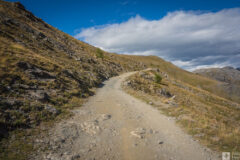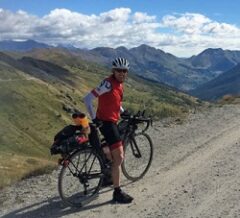Improving your bike handling skills and riding technique and learning how to conserve energy and ride more efficiently can increase your chances of success in bikepacking and ultra-distance cycling races.

Page Contents:
Pedaling
The first aspect of riding efficiently is to have a smooth pedaling style – using a higher cadence can help in this regard, but generally try to avoid bashing down on the pedals on each downstroke. You may be lucky and have automatically adopted a smooth style, but many people haven’t and most of us are poor at assessing our own pedaling style, so ask the people that you ride with to observe you and ask for tips from the people you see who look visibly smooth, stable, steady, and effortless on the bike. Having a professional bike fitter look at your position and pedaling style may also help, but as mentioned in the Riding Position page, take their advice merely as one opinion and not as a rigid, final word. Also, everyone’s pedaling style looks a lot smoother in the straightforward atmosphere of a fitting workshop, but it may be very different when out in the real world, climbing hills, etc.
By a smooth pedaling style I don’t mean putting energy in around the whole crank revolution; there is basically no evidence that pulling up on the pedal’s upstroke gives any real gain in overall power or efficiency – the leg has a limited amount of oxygen and energy supply and can easily use it all up in half of the pedal stroke, any energy used in the other half will take away that available to another section.
Non-round chainrings are marketed as improving pedaling smoothness, but the objective evidence supporting this claim is not very strong and the small gains can only be reliably shown for chainring shapes that are even more radical than what is commonly seen. Disadvantages include that you need to have such chainrings installed on all of your bikes so that your muscles are properly adapted to riding with them, shifting the chain between the chainrings is normally not very smooth, and the range of chainring sizes available is quite limited. So, I personally prefer to stick with round chainrings.
Here is some more advice on the topic by the GCN boys:
Energy Management & Descending
Riding efficiently is not only about using a smooth pedal stroke, but is also about gauging when to use your energy and when to conserve it. As discussed in the What Determines Cycling Speed? section, most of the resistance to forwards motion is caused by air resistance. You can use the tips in that section to reduce your air resistance, but also use that knowledge to know when to push hardest (see the How Air Resistance of the Cyclist Affects Cycling Speed page).
When climbing steeper hills, your speed is mostly determined by the effects of gravity, and speed increases almost linearly with an increase in power. When climbing shallower gradients or on the flat, your speed is mostly determined by air resistance, and speed becomes a less linear function of power. Putting out 200 watts on a steep climb instead of 150 watts will make you close to 33% faster (to be precise, this calculator gives a 30.2% faster speed on a 6% grade for 200 versus 150 watts using a few extra assumptions), but on the flat making a similar increase in power will only make you about 10% faster (11.6% according to the calculator). Your extra energy is therefore better used during a climb because there it will translate into more time saved than will putting in the same amount of extra energy on a flat section. This is discussed further on the Effects of Increasing Power page.
On descents, air resistance is even more important, and it’s hard to justify putting in any energy at speeds above 40-45 kph because of the minimal effect that will have on your speed – tucking into an extremely aerodynamic position and not pedaling is normally the best strategy in those situations (in fact, at a -6% gradient, the calculator gives a speed increase of 2.8% for a power increase of 33% from 150 to 200 watts, or a 3.8% increase for a 50 watts increase in power from 0 watts to 50 watts). So, be smart about when you do and don’t use your energy. On shorter rides and races, energy management is far less important, so it is often better to keep pedaling until a much higher speed, but the same is not true in an ultracycling race.
In addition, your average speed will be increased by more if you ride harder into a headwind than if you ride harder in still conditions or with a tailwind. This Bikeradar article helps to explain why.
Descending Technique
My number one tip for descending technique is to make sure that you always use the drops of your handlebars. I see far too many people who are not confident in descending holding their lever hoods the whole way down a descent; if they were to use their drops then they would have a lot better control and power in their braking because the levers are easier to operate from that position and their center of gravity would be lower, which would make them more stable. This GCN video includes many more tips on how to descend safely but quickly:
Bike Handling & Dirt Roads
Another way to conserve energy is to not brake too much. Practice carrying more speed through corners so that you don’t have to use energy or time to re-accelerate when leaving them. This applies even more on flat sections where you must put energy in to re-accelerate than on descents where you can just wait for gravity to do the work of re-acceleration.
Be confident in your bike handling so that you can ride over rough surfaces without needing to brake or ease off on the pedals; doing some mountain biking, cyclocross, or riding your road bike on light trails can all help here. I can put a lot of distance into some people that I ride with just by not touching my brakes while going over rough, tight, or twisty sections, without increasing my level of risk/danger, but simply because I’m comfortable doing those things at higher speeds than other people and have confidence in my bike handling skills.

The Transcontinental Race No. 3, 2015 was the first edition of the race that included a checkpoint with a gravel / dirt-road parcours. It was along the Strada dell’Assietta in the Italian Alps, which was about 40km of very rough, often steep dirt road. Similar sections have been included in most editions since then. In addition, every year most riders in the TCR encounter some significant sections of dirt roads at least once during their route that they weren’t expecting, regardless of how much time they spent planning and researching their route (including myself). Cobbled roads have also frequently been used as part of a required parcours, and you may find cobbles in the center of many towns in northern Europe.
It’s therefore a good idea to have some experience riding a road bike on such surfaces. Deliberately getting out of your comfort zone during training can be a lot of fun and is good preparation and a good test of your equipment. If you are not prepared for riding in such conditions, then you could easily lose a lot of time during the race struggling through such sections, getting punctures, becoming demoralized, or trying to find an alternative route.
Here are a few tips on riding dirt/gravel roads from the GCN boys:
Overheating Brakes & Braking Technique
Using poor braking technique can overheat both rim brakes and disc brakes, leading to serious problems. On extended descents, rather than holding both brakes on consistently, it’s much better to rotate between using each brake separately and/or to brake hard with both brakes but sporadically. This will allow the brakes and braking surfaces time to cool down slightly – even letting go of a brake for just a few seconds can make a big difference to the heat buildup and so avoid major problems.
The disc and pads in disc brakes can heat up to a point where they no longer provide much stopping power and normally afterwards the discs are distorted and the pads are glazed over and far less effective. If this happens, don’t poor water onto the discs because that makes the chance of them distorting even higher; it’s better to wait for them to cool down. With rim brakes, overheating the rims can result in the inner tube bursting and/or the rim distorting (both of which are more likely with full-carbon rims than with rims with aluminum braking surfaces).
Again, the best way to avoid all of these problems is to alternate the braking force between the two brakes on long descents, and don’t hold either brake on constantly. The advantages of disc brakes versus rim brakes are discussed on the Brake Types page.
This GCN video includes many more tips on braking technique:
Last significant page update: November, 2016

This is the final page in the Physical Training section, which is in Ride Far, Part I: The Rider.
